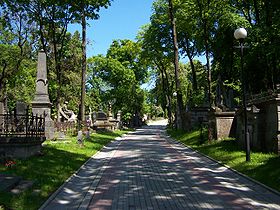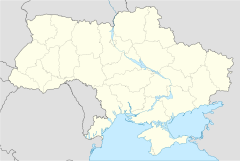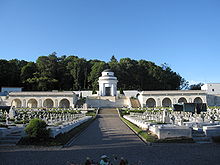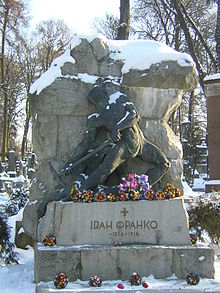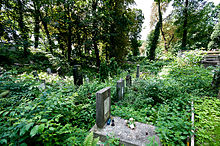- Lychakiv Cemetery
-
Личаківський цвинтар
Lychakiv Cemetery
Lychakiv Cemetery, 2007.Details Year established 1787 Country Ukraine Location Lviv Type Public (restricted) Size ? Number of graves ? Lychakiv Cemetery (Polish: Cmentarz Łyczakowski we Lwowie; Ukrainian: Личаківський цвинтар, translit. Lychakivs’kyi tsvyntar) is a famous and historic cemetery in Lviv, Ukraine.
Contents
History
Since its creation in 1787 as Łyczakowski Cemetery, it has been the main necropolis of the city's inteligentsia, middle and upper classes. Initially the cemetery was located on several hills in the borough of Lychakiv, following the imperial Austro-Hungarian edict ordering that all cemeteries be moved outside of the city limits. The original project was prepared by Karol Bauer, the head of the Lviv University botanical garden.
In mid-1850s the cemetery was expanded significantly by Tytus Tchórzewski, who created the present network of alleys and round-abouts. It then became the main city cemetery, and soon most other cemeteries were closed. The two largest that remained were the Yanivskiy Cemetery (Polish: cmentarz Janowski), with many working class graves) and the adjacent New Jewish Cemetery. Lychakivskiy Cemetery was used by all Christian sects in the city: in addition to Roman Catholics, it also included Eastern Rite Catholics, Protestants and Orthodox.
In 1925 the ashes of one of the unknown defenders of Lviv were transferred to the Tomb of the Unknown Soldier in Warsaw. Since 1999 there is also a monument to the Sich Riflemen located just outside the Polish mausoleum – Cemetery of the Defenders of Lwów.
After World War II the city was annexed by the Soviet Union to the Ukrainian SSR and the majority of the surviving pre-war inhabitants of the city were expelled to the former German areas awarded to Poland after the Yalta Conference. This started a period of devastation of historical monuments located at the cemetery. Up to 1971 many of the sculptures were destroyed; the cemetery of Lwów Eagles was completely destroyed and turned into a truck depot. However, in 1975 the cemetery was declared a historical monument and the degradation ended. Since the late 1980s, the cemetery has seen constant rebuilding and refurbishment and continues to be one of the principal tourist attractions of Lwów. Due to the history of complex Polish-Ukrainian relations, the Polish Eagles Cemetery was neglected because the Ukrainian authorities did not want to rebuild this monument of little Polish soldiers defending the city in 1920s. Though in the late 1980s, workers of a Polish company which were working in Khmelnytskyi started to redecorate and rebuild the necropolis from its ruins (which was not always legal according to Ukrainian law). Although the Ukrainian authorities tried to stop the works several times, the Poles managed to renovate this important memorial of great Lvovians.
In late 2006 the city administration announced plans to transfer the tombs of Stepan Bandera, Yevhen Konovalets, Andriy Melnyk and other key leaders of OUN/UPA to a new area of the cemetery dedicated to the Ukrainian national liberation struggle.[1]
Notable people
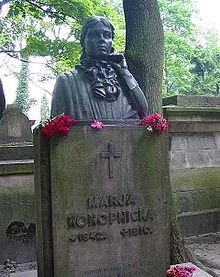 Tomb of Maria Konopnicka. Sculpture by Luna Drexlerówna.
Tomb of Maria Konopnicka. Sculpture by Luna Drexlerówna. Tomb of the poet Ivan Franko.
Tomb of the poet Ivan Franko.
Poles
Since the city for centuries used to be a centre of Polish culture, there are numerous famous Poles buried there. Among them are:
- Roman Abraham, general
- Stefan Banach, mathematician
- Władysław Bełza, writer
- Benedykt Dybowski, soldier, adventurer, ethnologist and biologist
- Mieczysław Garsztka, polish aviator
- Mieczysław Gębarowicz, historian
- Franciszek Ksawery Godebski, historian
- Artur Grottger, artist
- Zygmunt Gorgolewski, architect, author of the Lwów Opera
- Seweryn Goszczyński, poet
- Jan Nepomucen Kamiński, founder of the first theatre in Lwów
- Wojciech Kętrzyński, historian and name-sake of the city of Kętrzyn
- Maria Konopnicka, writer
- Juliusz Konstanty Ordon, officer
- Karol Szajnocha, historian
- Gabriela Zapolska, writer
- Franciszek Stefczyk, cooperative activist
Ukrainians
Among the notable Ukrainians buried there are:
- Vasyl Barvinsky, impressionist composer
- Ivan Franko, poet and reformer of the Ukrainian language
- Volodymyr Ivasyuk, composer
- Stanislav Ludkevych, composer
- Oleksandr Tysowskyj (alternately Alexander Tysovsky), founder of Ukrainian Scouting
- Mikhail Kobrin, theologian
- Markiyan Shashkevych, poet
- Anatole Vakhnianyn, composer and leading cultural figure
- Jacques Hnizdovsky, painter, printmaker, sculptor, bookplate designer and illustrator of numerous books, both in Ukrainian and English
Veterans' sections
There are also numerous parts of the cemetery in which veterans of most wars of 19th and 20th centuries are buried, including the quarters of veterans of:
- November Uprising
- January Uprising
- World War I
- Lwów Eagles (Cemetery of the Defenders of Lwów, reopened on 24 June 2005)
- Polish-Ukrainian War
- Polish-Bolshevik War
- Polish Defensive War
- World War II
- Victims of the NKVD
Gallery
-
Tomb of Stefan Banach and Riedl family
-
Tomb of Volodymyr Ivasyuk
-
Tomb of Ivan Krypiakevych
-
Tomb of Stanislaw Szczepanowski
-
Tomb of Oleksander Tysovsky
-
Tomb of Dmytro Vitovsky
-
Tomb of Jacques Hnizdovsky
-
Tombs of Stefan Stec, Stefan Bastyr and Władysław Toruń
See also
External links
- Detailed history of the Cemetery (Polish)
- Pictures of the Cemetery. 288 photo. V.Yashchuk
- Pictures of the Cemetery (Polish)
- More pictures of the Cemetery (captions in Polish)
- Pictures of Defenders of Lwów Cemetery (Polish)
- Lychakivskiy Cemetery on city plan: F-9; Inter-war cemetery list, p. 23, Plan Lwowa, W. Horbay, 1938 (in Polish; reprinted Wrocław, 1986).
- Review of Cemetery as tourist attraction
History Armenian Statute · Dormition Brotherhood · Jesuit Collegium · First Siege by Cossacks · Second Siege by Cossacks · Lwów Oath · Siege by Turks · Leopolis Triplex · Stauropegion Institute · Stauropegion Press · Ossolineum · Galician Rada · Halytsko-Ruska Matytsia · Prosvita · Ruthenian Triad · Ruthenian National House · Hutsul Secession · Batiars · Lwów Eaglets · Battle 1918 · Pogrom 1918 · Battle 1920 · Secret Ukrainian University · School of Logic · School of Mathematics · Battle 1939 · Massacre of Lviv professors · Lviv pogroms · Lemberg Ghetto · Lwów Uprising · Sknyliv airshow disaster
Religion Armenian Cathedral · Cathedral of St. George · Chapel of the Boim family · Bernardine Church · Bridgettine Convent · Carmelite Church · Convent of Benedictines · Church of St. Anne · Church of John the Baptist · Church of Mary of Snow · Church of St. Elizabeth · Church of St. Mary Magdalene · Church of St. Onuphrius · Church of the Dormition · Church of the Purification, Lviv · Church of the Transfiguration · Dominican Church · Jesuit Church · Latin Cathedral
Attractions Arena Lviv · Arsenal Museum · Bandinelli Palace · Black Kamienica · Catholic University · Cemetery of the Defenders of Lwów · Freedom Boulevard · Government House · King Cross Leopolis · Korniakt Palace · Lviv High Castle · Lviv University · Lychakivskiy Cemetery · Market Square · Mickiewicz Square · National Museum · Polytechnic University · Liubomyrsky Palace · Metropolitan Palace · Old Town · Pharmacy Museum · Pototsky Palace · Sapieha Palace · Scottish Café · Shevchenkivskyi Hai · Theatre of Opera and Ballet · Town Hall · Ukraina Stadium · Union of Lublin Mound
Transport Categories:- Cemeteries in Ukraine
- Monuments and memorials in Ukraine
- Polish culture
- Buildings and structures in Lviv
Wikimedia Foundation. 2010.

